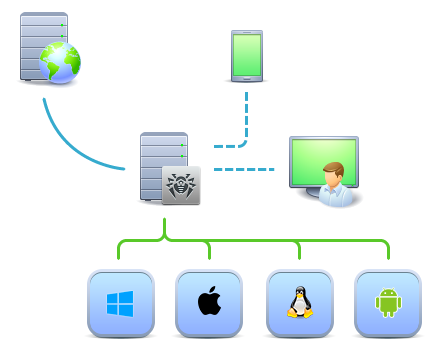Dr.Web Enterprise Security Suite is designed for implementation and management of integrated and secure complex anti-virus protection for either local company network (mobile devices included) or home computers of employees.
A sum of computers and mobile devices with Dr.Web Enterprise Security Suite cooperating components installed represents a single anti-virus network.

|
Dr.Web Server |
|
HTTP/HTTPS |
|
Dr.Web Security Control Center |
|
TCP/IP network |
|
Dr.Web Mobile Control Center |
|
Updates delivered via HTTP/HTTPS |
|
Protected station |
|
Dr.Web GUS |
The logical structure of the anti-virus network
Dr.Web Enterprise Security Suite anti-virus network has a client-server architecture. Its components are installed on computers and mobile devices of users and administrators, as well as computers functioning as LAN servers. Anti-virus network components exchange information via TCP/IP network protocols. Anti-virus software can be installed (and managed afterwards) onto protected stations either via LAN, or the internet.
Central Protection Server
Central protection Server (Dr.Web Server) is installed on a computer in anti-virus network. The installation can be performed on any computer, not necessarily the one functioning as a LAN server. General requirements to such computer are given in the System Requirements section.
Cross-platform nature of the Dr.Web Server software allows using a computer under any of the following operating systems as a Dr.Web Server:
•Windows OS,
•UNIX system-based OS (Linux, FreeBSD).
Central protection Server stores distribution kits of anti-virus packages for different operating systems on protected computers, updates for virus databases and anti-virus packages, license keys and anti-virus package settings for protected computers. Dr.Web Server receives updates of anti-virus protection components and virus databases via the internet from Dr.Web Global Update System and propagates the updates to protected stations.
Single Database
The single database is connected to the central protection Server and stores statistics about anti-virus network events, Dr.Web Server settings, parameters of protected stations and anti-virus components installed on protected stations.
Central Protection Control Center
Central protection Control Center is automatically installed with Dr.Web Server and provides a web interface for remote managing of Dr.Web Server and the anti-virus network by means of editing the settings of Dr.Web Server and protected computers settings stored on Dr.Web Server and protected computers.
The Control Center can be opened on any computer with a network access to Dr.Web Server. The Control Center can be used almost under any operating system with full use in the following web browsers:
•Windows Internet Explorer,
•Microsoft Edge,
•Mozilla Firefox,
•Google Chrome.
The list of possible variants of use is given in the System Requirements section.
The Web server is one of the Control Center parts that is automatically installed with Dr.Web Server. The main purpose of the Web server is to ensure operation of the Control Center web pages and client network connections.
Central Protection Mobile Control Center
Dr.Web Mobile Control Center is available as a separate component for mobile devices under iOS and Android. Basic requirements for devices to run the application are given in the System Requirements section.
The Mobile Control Center connects to Dr.Web Server over encrypted protocol using the anti-virus network administrator credentials.
You can download Dr.Web Mobile Control Center from the Control Center or from App Store and Google Play directly.
Protection of Network Stations
Protected computers and mobile devices in the network have control module (Agent) and anti-virus package installed for corresponding operating system.
Cross-platform nature of the software ensures that anti-virus protection of computers and mobile devices is provided under the following operating systems:
•Windows OS,
•UNIX system-based OS,
•macOS,
•Android OS.
Protected stations can include both user computers and LAN servers. Anti-virus protection of the Microsoft Outlook mail system is supported as well.
The control module updates anti-virus components and virus databases regularly by downloading them from Dr.Web Server. It also sends information about virus events on protected computer to Dr.Web Server.
If the central protection Server is not accessible, virus databases on protected stations can be updated from the Global Update System via the internet.
Providing Connection between Anti-virus Network Components
To provide stable and secure connection between anti-virus network components, the following features are presented:
Dr.Web Proxy Server
Proxy Server can be optionally included in an anti-virus network. The main function of the Proxy Server is to provide connection between Dr.Web Server and protected stations in cases when direct connection is impossible.
Traffic compression
To reduce network traffic to minimum, special compression algorithms come into effect when anti-virus network components exchange the data.
Traffic encryption
Data transferred between anti-virus network components can be encrypted to provide additional security level.
Additional Features
NAP Validator
NAP Validator is provided as a separate component and allows to use Microsoft Network Access Protection (NAP) technology to check health of protected stations software.
Repository loader
Dr.Web Repository loader is provided as a separate utility and allows to download products of Dr.Web Enterprise Security Suite from Dr.Web Global Update System. It can be used for downloading of Dr.Web Enterprise Security Suite products updates and placing them on a Dr.Web Server, which is not connected to the internet.
Dr.Web Scanning Server
Dr.Web Scanning Server is provided as a separate component. It is designed for operating in virtual environments, The Scanning Server is installed on a separate virtual machine and processes anti-virus scanning requests from other virtual machines.